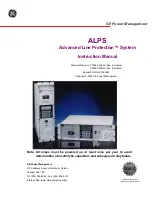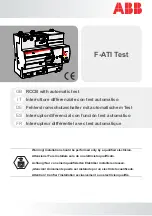
There is a risk that the current into the generator at inadvertent energization will be
limited so that the “normal” overcurrent or underimpedance protection will not detect
the dangerous situation. The delay of these protection functions might be too long. The
reverse power protection might detect the situation but the operation time of this
protection is normally too long.
For big and important machines, fast protection against inadvertent energizing should,
therefore, be included in the protective scheme.
The protection against inadvertent energization can be made by a combination of
undervoltage, overvoltage and overcurrent protection functions. The undervoltage
function will, with a delay for example 10 s, detect the situation when the generator is
not connected to the grid (standstill) and activate the overcurrent function. The
overvoltage function will detect the situation when the generator is taken into operation
and will disable the overcurrent function. The overcurrent function will have a pick-up
value about 50% of the rated current of the generator. The trip delay will be about 50
ms.
10.1.3
Setting guidelines
IP15009-1 v2
GUID-F7AA2194-4D1C-4475-8853-C7D064912614 v4
When inverse time overcurrent characteristic is selected, the trip time
of the stage will be the sum of the inverse time delay and the set
definite time delay. Thus, if only the inverse time delay is required, it is
important to set the definite time delay for that stage to zero.
M13088-237 v3
The parameters for the general current and voltage protection function (CVGAPC) are
set via the local HMI or Protection and Control Manager (PCM600).
The overcurrent steps has a
IMinx
(
x
=1 or 2 depending on step) setting
to set the minimumpickup current. Set
IMinx
below
PickupCurr_OCx
for every step to achieve ANSI reset characteristic according to
standard. If
IMinx
is set above
PickupCurr_OCx
for any step the ANSI
reset works as if current is zero when current drops below
IMinx
.
10.1.3.1
Directional negative sequence overcurrent protection
M13088-3 v5
Directional negative sequence overcurrent protection is typically used as sensitive
ground-fault protection of power lines where incorrect zero sequence polarization may
result from mutual induction between two or more parallel lines. Additionally, it can be
used in applications on underground cables where zero-sequence impedance depends
on the fault current return paths, but the cable negative-sequence impedance is
1MRK 505 370-UUS A
Section 10
Multipurpose protection
Busbar protection REB670 2.2 ANSI
273
Application manual
Summary of Contents for RELION REB670
Page 1: ...RELION 670 SERIES Busbar protection REB670 Version 2 2 ANSI Application manual ...
Page 2: ......
Page 24: ...18 ...
Page 40: ...34 ...
Page 72: ...66 ...
Page 102: ...96 ...
Page 266: ...260 ...
Page 272: ...266 ...
Page 290: ...284 ...
Page 432: ...426 ...
Page 542: ...536 ...
Page 552: ...546 ...
Page 553: ...547 ...
















































